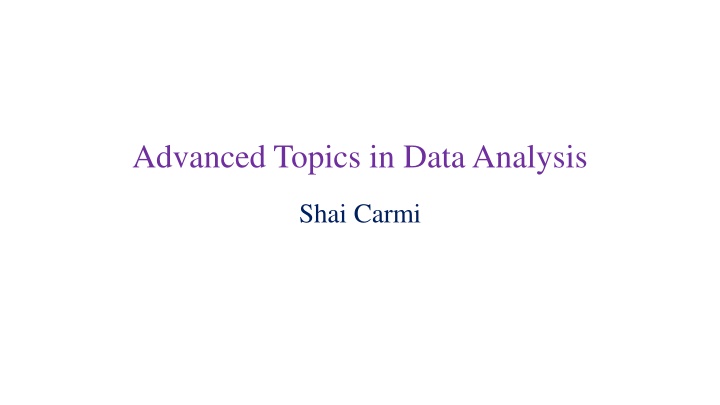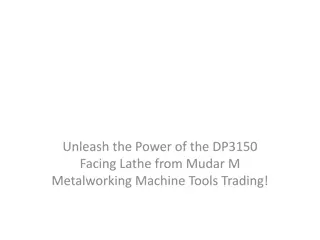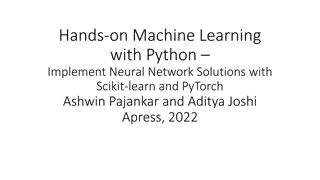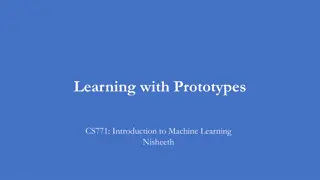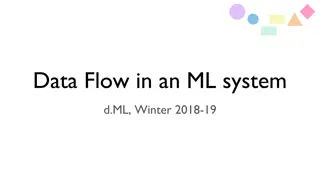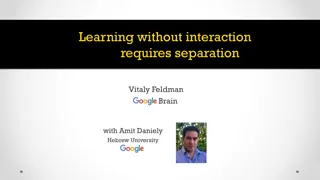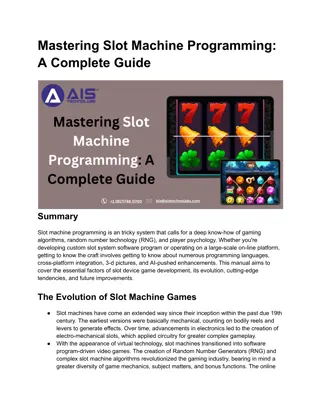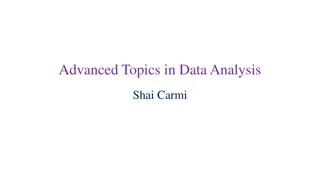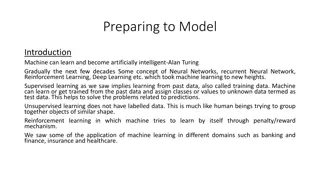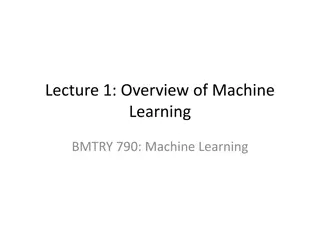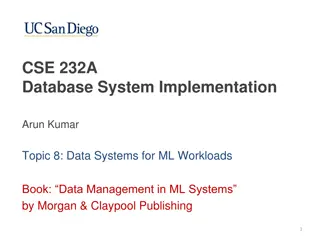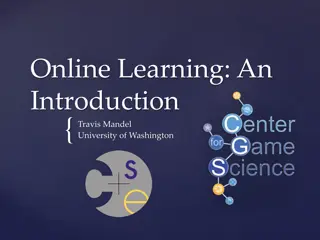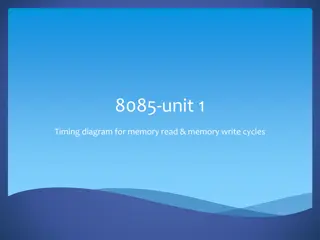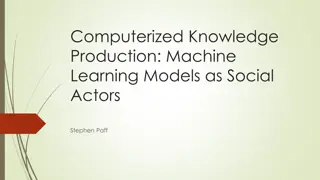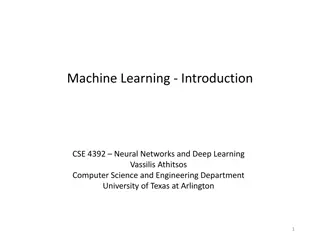Introduction to Advanced Topics in Data Analysis and Machine Learning
Explore advanced topics in data analysis by Shai Carmi, covering machine learning basics, regression, overfitting, bias-variance tradeoff, classifiers, cross-validation, with additional readings in statistical learning and pattern recognition. Discover the motivation behind using data for medical diagnosis in a revolutionary approach to leveraging patient data for accuracy and efficiency.
Download Presentation

Please find below an Image/Link to download the presentation.
The content on the website is provided AS IS for your information and personal use only. It may not be sold, licensed, or shared on other websites without obtaining consent from the author.If you encounter any issues during the download, it is possible that the publisher has removed the file from their server.
You are allowed to download the files provided on this website for personal or commercial use, subject to the condition that they are used lawfully. All files are the property of their respective owners.
The content on the website is provided AS IS for your information and personal use only. It may not be sold, licensed, or shared on other websites without obtaining consent from the author.
E N D
Presentation Transcript
Advanced Topics in Data Analysis Shai Carmi
Introduction to machine learning Basic concepts o Definitions and examples o Regression o Overfitting o Bias-variance tradeoff o Classifiers o Cross validation o Discussion
Bibliography An Introduction to Statistical Learning: with Applications in R o Gareth James, Daniela Witten, Trevor Hastie, and Robert Tibshirani o Springer, 2013 o PDF available online (http://www-bcf.usc.edu/~gareth/ISL/) Learning From Data o Yaser S. Abu-Mostafa, Malik Magdon-Ismail, and Hsuan-Tien Lin o AMLBook, 2012
Advanced reading The Elements of Statistical Learning: Data Mining, Inference, and Prediction o Trevor Hastie, Robert Tibshirani, and Jerome Friedman o Springer, 2009 o Available online (http://statweb.stanford.edu/~tibs/ElemStatLearn/download.html) Pattern Recognition and Machine Learning o Christopher M. Bishop o Springer, 2007
Motivation A person arrives at the emergency room with a set of symptoms that could possibly be attributed to one of two medical conditions o Myocardial infarction vs heartburn o Bacterial vs viral infection o Overdose from one of two possible drugs The person undergoes multiple tests o E.g., blood pressure, temperature, physical examination, X-ray, urine test, biopsy We also have clinical and demographic information: o E.g., medical background, sex, age, occupation, address, family history How to diagnose?
Motivation Current method of diagnosis could be: o Call an expert physician to interpret the results o Perform a decisive but expensive or lengthy additional test o Look in papers and books to understand the underlying biology But we would like to save time, money, and personnel and improve accuracy We have data: information on thousands of previous patients o We have their test results + clinical and demographic information o We also saved their previous ground truth diagnosis Can we use the data to diagnose a new incoming patient?
Basic definitions Data: A collection of data points ?1,?2,?3, ,?? o Each represents one experiment, person, biospecimen, image, etc. o Called training set , or input o Each point is usually multi-dimensional, ??= (??,1,??,2, ,??,?), with dimension d o Each component in the vector is called a feature , a variable , or dimension o ? is the sample size (sometimes ?) o Often, ? and ? very large ( big data ) Often, each data point has a label: ?1,?2,?3, ,?? (or output ) o Tell us something about each data point o Labels can be binary or continuous
What does machine learning do? We first collect data points and labels from ? experiments/individuals Supervised learning: o Training/Learning: learn connections between features and labels o Predictlabels for new data points o Classification: predict a binary label (e.g., sick/healthy) o Regression: predict a continuous label (e.g., severity of symptom) Unsupervised learning: o Data points are available, but no labels o Determine the relationship between data points, identify groups Identify which features are important and in what ways
Supervised learning: Classification Training data: ? = 52 Features: temperature, blood pressure (? = 2) Label: sick/healthy learning Sick Healthy ? ? ? Temperature A machine learning classifier divides the space into the different classes We can then assign a label to each new point The classifier we learned is called our model ? Class separation line ? Blood pressure
Classification examples Data points: o Blood counts o Genome sequence o Monitor recordings o MRI photos o Heart rate and blood pressure recordings o Electronic medical records, lifestyle or demographic parameters Labels: o Typically, risk to develop a disease over a given period ( clinical outcome ) o Precise (=expert) diagnosis (e.g., radiologists, pathologists) o Success of treatment/complications o Side effects of drugs or procedures o Health-related behavior What are the features of each data point? What is the dimension? What is the typical sample size?
Complex models learning More complex ( flexible ) models than a straight line are often needed Complex models can improve accuracy, but Are more difficult to interpret May end up leading to lower accuracy o o
Learning a classifier learning What does learning mean? We select the method (or algorithm, or type) of classifier (e.g., divide the space using a straight line) o Find the parameters of the classifier (e.g., slope and intercept for a line) that classify the training set with the highest accuracy o
How to determine whether a mutation is pathogenic? Many mutations are discovered in the genomes of patients Which of them is pathogenic? Which is benign? Each mutation is characterized by many features: o Substitution or deletion, intergenic or genic, distance to coding sequence or splice site, impact on protein, gene expression in each tissue, epigenetics (methylation, chromatic modification, transcription factor binding, etc.), evolutionary conservation, polymorphism in the population For a small training set, mutations were heavily investigated and labeled as pathogenic/benign A classification algorithm learns the connections between features and pathogenicity We can now predict which of the new mutations is pathogenic
Drug discovery Which one of millions of small molecules binds to a target (e.g., a protein)? Each molecule in the database is encoded by a large number of chemical and physical properties (features) For a small training set, actual (expensive) experiments were performed to label them as binders/non-binders A classification algorithm learns the connections between features and binding ability We can now predict which of the other molecules in the database can bind Can we distinguish sweet and bitter molecules? https://www.biorxiv.org/content/early/2018/09/27/426692 Other papers have attempted to predict side effects, etc.
Predicting the glycemic response The damage of a meal is approximated by the total rise in glucose levels How to personalize food recommendations that will minimize the glycemic response? Each individual is characterized by several features For a small training set, the glycemic response (output) was measured A regression algorithm was applied to learn the connections between the features and the response, and predict the response for new meals
Introduction to machine learning Basic concepts o Definitions and examples o Regression o Overfitting o Bias-variance tradeoff o Classifiers o Cross validation o Discussion
Supervised learning: regression Training data: ? 300 Features: TV advertising budget (? = 1) Label/output: Sales Consider the case when the output variable (?) is continuous o Sales of a product ($) We have a training set with values of both the features (?) and the output (?) o Here one feature: TV advertising budget We would like to learn a function that relates ? to ?: regression Sales? For a new value of ?, we will use the regression function to predict? o Predict sales for a given TV budget
Simple linear regression Training data: ? 300 Features: TV advertising budget (? = 1) Label/output: Sales Very often, there is an approximately linear relation between the input and output (? and ?) The function that relates ? to ? is a line (the regression line ) Predicted sales Learning: find the line that best fits the training data Prediction: for a given ?, find the value of ? on the regression line Sales?
Non-linear regression The relation may not always be linear In that case, our model will be a regression curve, more complicated than a straight line o For example, a parabola, sigmoid Predicted income Learning: find the regression curve that best fits the training data Prediction: for a given ?, find the value of ? on the regression curve Income?
How do we learn? Consider a regression problem o Assume ? = 1, input: ?1,?2, ,??, output: ?1,?2, ,?? Learning: find a function ? = ?(?) that is a good fit to ?(on the training set) But what does it mean a good fit? Define the Mean Squared Error (MSE) as 1 ? ?=1 ?? ?? 1 ? ?=1 ? ? 2= 2 MSE = ? ?? ?? Learning: finding a function ?(?) that minimizes the MSE in the training set
Reminder: straight lines A straight line ? = ?? + ? is characterized by a slope ? and an intercept ? ? = ?? + ? ? < 0 ? The slope is the change in ? due to a change of one unit in ? ? > 0 ? ? The intercept is the value of ? when ? = 0 ?
Learning simple linear regression Goal: find slope ? and intercept ? such that ?? + ? is a good fit to ? (in MSE) Find ? and ? that minimize 1 ? ?=1 ???+ ? ?? ? 2 Errors This is the well known least-squares problem ? ?=1 ?? ? ?? ? ?=1 ?? ?2 Solution: ? = , ? = ? ?? ?
Multiple linear regression Simple linear regression: single feature o ? = 1 o ? ?? = ?0+ ?1?? is a linear function of ?? ? = 2 Multiple linear regression: multiple features o ? > 1 o ? ?? is a linear function of ??,1,??,2, ,??,? Example: ? = 2 o ? ??,1,??,2 = ?0+ ?1??,1+ ?2??,2 The output depends linearly on each of the inputs
Non-linear regression The regression curve ?(?) need not be linear o Often, polynomials are used o ? ? = ?0+ ?1? + ?2?2 (? = 1) o ? ??,1,??,2 = ? + ?1??,1+ ?2??,1 2+ ?1??,2+ ?2??,2 2 (? = 2) For either multiple or non-linear regression, we attempt to find ?(?) that minimizes the MSE in the training set, as before: o Minimize 1 ? ?=1 ? ?? ?? ? 2 The details on how to find ?(?) for general multiple or non-linear regression are complicated and will not be discussed
Introduction to machine learning Basic concepts o Definitions and examples o Regression o Overfitting o Bias-variance tradeoff o Classifiers o Cross validation o Discussion
Cheating When solving a regression problem, we attempt to find the regression function ?(?) that minimizes the MSE in the training set Suppose we have two data points ? A straight line has 2 parameters: ? = ?0+ ?1? Every two points can be connected by a straight line Thus, we can always find a regression line with MSE=0 No error at all on the training data! ? What if we have more data points?
Cheating Suppose we have ? data points A polynomial of degree ? 1 has ? parameters o ? = ?0 + ?1? + + ?? 2?? 2 + ?? 1?? 1 ? ? = 4 Every set of ? points can be connected by a polynomial of degree ? 1 ? We can thus always find a function with no error (MSE=0) on the training set! Did we just solve all possible learning problems?
Cheating Green: the true function Blue: data points o True function + noise Red: fit with a polynomial of degree ? Very large MSE The higher ?, the better the fit Or not? MSE=0!
Did we correctly inferred the true function? The higher ?, the better the fit on the training data But did we correctly infer the structure of the true function that generated the data? Very large MSE Will we be able to give a good prediction for a new data point not in the training data? MSE=0!
Overfitting A machine learning algorithm learns to minimize the error in the training set But we really care about the error in a test set, an independent set of data points, for which the label is unknown to the learning algorithm The test set represents the realistic performance A method that works very well on the training set but poorly on the test set is overfitting
Overfitting When using models that are too complex, we are effectively fitting the noise in the data Therefore, the resulting models do not generalize well to future data sets Overfitting Good fit
Underfitting Is it better to have very simple models? Models too simple do not capture the structure of the true function, and do not perform well even on the training data Called underfitting
Overfitting and underfitting Underfitting Is it better to have very simple models? Very simple models do not capture the structure of the true function, and perform poorly even on the training data Called underfitting Overfitting Good fit
Overfitting We Prediction error (e.g., MSE) Test error We want to be here Training error Good fit Low High Model complexity/flexibility
Introduction to machine learning Basic concepts o Definitions and examples o Regression o Overfitting o Bias-variance tradeoff o Classifiers o Cross validation o Discussion
What are the sources of error? Consider the squared test error for a specific value of ?: SEtest(?) = ? ? ?2 Will the test error change with a different training set and by what magnitude? ? What s the best we can achieve? o E.g., with an infinitely sized training set ?(?) test error
A simple experiment The true output function is ? = sin? We have two data points Learning the best horizontal line Learning the best straight line ? Test error ? ? ?(?) ? ?
What happens if we use a different training set? We assume that training sets are drawn randomly Each different training set will lead to a different regression line The models differ on their test errors The mean of all lines for one specific ? ? Test error ? ? ?(?) ? ?
All possible training sets The models differ on how far they are on average from the truth They also differ on how much the difference (from the truth) varies across training sets Grey area: The variance of the prediction across training sets Red line: The mean of all possible training sets The average prediction is far from the truth The average prediction is close to the truth ? ? Highly variable across training sets Not much variation across training sets ? ?
The bias-variance decomposition 2 Consider the squared (test) error: SEtest(?) = ? ? ? The bias-variance decomposition theorem: ? SEtest? = Bias ?2+ Var ? Bias ? = ? ? ? Var ? = ? ? ? ? ? ? ? 2 The expectations are over all possible choices of the training set
Bias and variance in linear regression Bias: distance from the average of the prediction over all training sets Variance: the extent to which the prediction varies across training sets
Bias and variance Large bias, small variance Small bias, large variance Large bias, large variance Small bias, small variance
The bias-variance decomposition: explanation = Bias ?2+ Var ? ? SEtest? The bias is due to simplifying assumptions of our model o For example, using a straight line to approximate a parabola o The bias is squared in the formula of the MSE, so its contribution is always positive The variance is how much ?(?) will vary across different training sets o The more the model depends on the specific details of the data, the higher the variance o We thus expect more complex models to have higher variance
The bias-variance tradeoff Simple models: high bias, low variance High bias Low variance Complex models: low bias, high variance Low bias High variance
The bias-variance tradeoff Variance: the extent to which the prediction varies across training sets Bias: distance from the average of the prediction over all training sets Simple model Low variance High bias Low bias Complex model High variance
The bias-variance tradeoff Both bias and variance contribute to the error We need to find the complexity that has the minimal sum of bias and variance SEtest= Bias2+ Var Comment: usually, the squared error is averaged over all possible values of ? in the test set
The bias-variance tradeoff Low bias High variance High bias Low variance Prediction error Test error We want to be here Training error Good fit Low High Model complexity/flexibility
How to reduce error Increasing the sample size will always reduce the test error The training error is lower (better) for small ?, because we can perfectly fit a small number of data points Complex model Simple model Test error Test error Error Training error Error Variance Bias Training error Sample size ? Sample size ?
Increasing the sample size Adding data reduced the variance of the more complex model The complex model has a lower bias and thus the total test error is overall lower Bias = 0.21 Var = 1.69 Bias = 0.5 Var = 0.25 Bias = 0.5 Var = 0.1 Bias = 0.21 Var = 0.21 Test error = 1.90 Test error = 0.75 Test error = 0.6 Test error = 0.42
